As we wrap up the eight weeks of
Building Research Competency, I can not help but think of how much my
understanding of research has improved, and that I will always be much more
critical of any article I read or any quote of research results.
I want to begin by thanking Dr.
Parrish for breaking down the course in a very effective and enjoyable way. It
was always interesting and informative, but not overwhelming.
The insight that I feel I walk
away with is primarily that there is good reliable valid research, and that
there is not so good and doubtful research. So the walk away message is to be
critical with every research study we encounter. From my previous career in
healthcare, I had some idea of how to read research studies and how to analyze
their quality, but with the early childhood field there is an added element of
qualitative research which is critical for this field. I realize now that
methods can be combined and that validity as well as equity are important. I
also realize that consent is also applicable to the children in the studies and
not just the authorized adult, and that the ethical issues with studying
children is more vast and intense than other fields.
I found the chapters on
observation and interviews very interesting and practical. In addition, having
learnt terms for the different ways we observe or interview and collect data,
made me feel more prepared and resourced for conducting research. The same
applies to the concept of sampling and choosing participants.
Being a very practical person,
with little affinity for the philosophical side of issues, I had a harder time
with chapters that explored equity and ethics. I found them very interesting
and important, but not high on my personal priority list. This was a good
challenge for me, since they are an integral part of research.
Although I realize that early
childhood professionals have a vast range of responsibilities and career paths,
adding research to that profession has added a dimension to the field in my
perspective. In addition, for those of us not conducting research, I realize
now that we are obligated to remain informed of the current research findings
that influence our daily work.
I want to thank all my classmates
for their comments, remarks and questions to my posts; it is always very
exciting to read how others interpret my work. I am thankful also for all your
hard work and posts which have taught me so much.
Wishing you all luck in future
courses and in our precious field of work.



.jpg)
